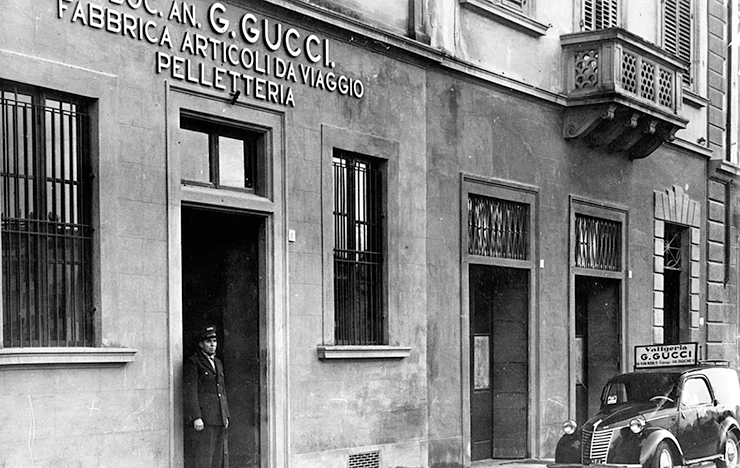
Guccio Giovanbattista Giacinto Dario Maria Gucci (26 March 1881 – 2 January 1953) was an Italian fashion designer, known for being the founder of the fashion house “Gucci”.
1881-1899
Guccio Gucci was born in Florence, Tuscany region of Italy, in the family of a leather craftsman Gabriello Gucci and Elena Santini. Guccio’s early years were steeped in the craftsmanship of leather together with his father. Inspired by his surroundings, young Guccio developed a keen eye for quality and design.
1899
As a teenager, in 1899, Guccio moved to London to start working there at the known Savoy Hotel. Getting inspired by the elegant and rich upper-class hotel guests and their luxury luggage, he decided to return to Florence with an idea to start making luxury luggage and accessories.
1921
In 1921, Guccio Gucci opened his first small workshop in Florence, specializing in producing saddles, leather bags and other accessories for horsemen. The initial years were modest, but his dedication to excellence and commitment to producing high-quality items garnered local attention.
1921-1938
As the demand for Gucci’s products grew, so did his ambitions. In 1938, he expanded his workshop and opened a boutique in Rome. This marked the official establishment of the House of Gucci as a luxury brand. Gucci’s designs became synonymous with elegance and sophistication, attracting a discerning clientele.
1940-1950
The post-war era saw Gucci’s creativity flourish. In the 1940s, he introduced the iconic Bamboo Bag, a revolutionary design featuring a bamboo handle. This unique creation became an instant classic and a symbol of Gucci’s innovation.
In 1953, the iconic interlocking G logo was introduced, representing the founder’s initials and forever embedding the Gucci name in the fashion lexicon. This distinctive logo became a hallmark of the brand’s identity and authenticity.
1960-1970
The 1960s marked a period of global expansion for Gucci. The brand opened stores in Milan and New York, solidifying its international presence. Celebrities and influential figures, including Jackie Kennedy, became devotees of Gucci’s designs, catapulting the brand to international fame.
Despite the passing of Guccio Gucci in 1953, his legacy continued to thrive under the leadership of his sons. The family’s commitment to quality craftsmanship and innovative design ensured that the House of Gucci remained a dominant force in the fashion world.
1980-2000
The 1980s brought both success and challenges to Gucci. Internal family disputes and management issues threatened the brand’s reputation. The disputes centered around the control of the Gucci fashion empire, and primarily involved Maurizio Gucci, the grandson of the founder, who inherited the majority stake in the company in 1983. Tensions escalated as Maurizio clashed with other family members, notably his cousins Paolo and Aldo Gucci. Aldo, a key figure in expanding the brand globally, faced legal troubles and imprisonment for tax evasion in 1986, creating a power vacuum within the company. In 1989, Maurizio’s decision to sell his stake to an investment group intensified the family feud, leading to legal battles that persisted into the 1990s. The internal strife played a role in the decline of the Gucci brand during this period.
However, in the mid-1990s, a renaissance occurred under the leadership of Tom Ford, who revitalized Gucci with bold and sensual designs. This era marked a resurgence for the brand, making it a powerhouse in the fashion industry once again.
2010-2024
In recent years, Gucci has continued to evolve, embracing a contemporary and eclectic aesthetic, blending tradition with modernity. Gucci remains a symbol of luxury and sophistication, adapting to the ever-changing landscape of fashion.
The post Guccio Gucci appeared first on The Fashiongton Post.
